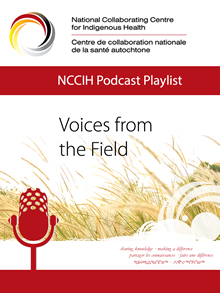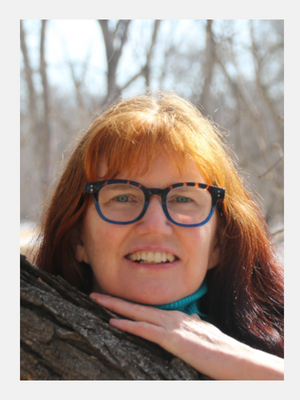 NCCIH Voices from the Field Podcasts
NCCIH Voices from the Field Podcasts
Voices from the Field
Welcome to Voices from the Field, a podcast series produced by the National Collaborating Centre for Indigenous Health (NCCIH), which focuses on innovative research and community-based initiatives promoting the health and well-being of First Nation, Inuit and Métis peoples in Canada.
Episode 21 – A discussion on the higher COVID-19 rates in Manitoba’s First Nations compared to non-First Nations linked to limited infrastructure on reserves
In this episode, we hear from co-authors Ajarat Adegun and Shirley Thompson, both with the University of Manitoba. They provide an overview of their article titled, Higher COVID-19 rates in Manitoba’s First Nations compared to non-First Nations linked to limited infrastructure on reserves.
As part of this podcast, they discuss a mapping exercise they undertook to find out the infrastructural inequalities experienced by First Nations versus non-First Nations communities in the province, particularly in the northern regions. What they found was that there are specific socio-economic factors that continue to place First Nations people on reserve at greater risk of developing and transmitting infectious diseases like COVID-19, including the built environment (e.g. housing, roads, and access to hospitals).
A note to listeners that Shirley’s microphone settings changed midway through the recording.
Listen on SoundCloud
Bios

Shirley Thompson is the Principal Investigator with the Mino Bimaadiziwin Partnership and Associate Professor with the Indigenous Focus Group at the Faculty of Environment, Earth and Resources, University of Manitoba. This Mino Bimaadiziwin Partnership works to build capacity, food security and houses in Northern Manitoba through partnerships for community-led post-secondary education with First Nations and the international movement for Ecosystem Restoration Camps (ERC). For more information check: http://ecohealthcircle.com/

Ajarat Adegun is completing her Master of Natural Resources at the Natural Resources Institute, University of Manitoba. She completed her B.Sc. (Hons), M.Sc. Geology, and M.Sc. Energy & Environment in Nigeria. Ajarat is currently examining the geographical and statistical relationship between higher COVID-19 rates and limited infrastructure in First Nations reserves compared to other rural communities in Manitoba, supervised by Dr. Shirley Thompson. Ajarat hopes her research will inform building back better for better health outcomes, serving as an advocacy tool to improve infrastructural development and the public health of Indigenous and all communities in Manitoba and across Canada.
Transcript
Ajarat Adegan: My name is Ajarat Adegan. I'm from Nigeria. I'm currently completing my Masters of Natural Resources Management at the Natural Resources Institute of the University of Manitoba. Currently, my master's research is me examining the geographical and statistical relationship between higher COVID-19 rates in First Nations in Manitoba with the rest of rural communities in Manitoba. Thank you.
Shirley Thompson: And my name is Shirley Thompson. I'm an Associate Professor at Clayton H. Riddell, at the Faculty of Earth Environment and Resources. I'm also the principal investigator of the Mino Bimaadiziwin Partnership that focuses on housing and also food with the University of Manitoba.
Roberta Stout: What I would like to start out by asking are what are the principal challenges for on reserve First Nations communities in Manitoba that place them at greater risk for infectious diseases, such as COVID-19. Ajarat, maybe I'll just back up and ask whether you could provide a general overview of the journal article and the findings.
Ajarat Adegan: For this article, what we did was to do a very vast literature review, so identify the factors that could be responsible for the higher rates of COVID-19 that we observed in First Nations in Manitoba. This is open access data that is available on the Government of Manitoba’s COVID-19 hub. So, we needed to identify the factors like what could be responsible for this and also to look at the relationship available, like the relationship between these factors, and then using previous contagious diseases, the statistics that were recorded for that, for example tuberculosis and also epidemics such as the H1N1, which also give the same kind of relationship between the rates observed in First Nations and the rest of Manitoba. So, we set out to investigate this using the health equity framework and this is done by doing a statistical and geographical analysis to look at these factors.
So initially after doing the literature review, then we set up to do the mapping. The mapping is like the foundation of the study. So, we got the data from different sources, primarily the Government of Manitoba COVID-19 hub. We got the social economic factors, which is housing, roads, hospitals; we got that from the Statistics Canada website [which] is also open access data.
To have it in a format that can easily be mapped, we were able to produce a thematic map. A thematic map is a map that shows the variation of each of these factors using different colours so anybody could pick up the map and you have a visualization of the situation. So, for housing data we explored three different housing attributes, which is the not suitable housing, major repairs and housing needed, and also average household size. And the average household size is just as the name implies – [it] is just the number of people living in the house so divided by the number of bedrooms available. And for roads, what we did was to categorize the communities into different access types to service centers. And for hospitals, only one First Nation community, which is the Norway [House] First Nation, has a hospital. So at the end of the day, we’re able to map this and what we discovered is that the same way you have higher COVID-19 rates, where that's observed, this coincides with whether there is deficient - in terms of house suitability, that is where you have higher not suitable housing, and this is observed in the far remote communities such as the Island Lake communities and Pukatawagan as well. And for major repairs and housing needed, similarly it shows the same relationship where you have higher COVID-19 rates correspond[ing] to where you have higher percentages of the houses needing major repairs. The same thing for average household size. The number in the rest of Manitoba is 2.4 but for most First Nations communities you have the average household size greater than 4. Even in Island Lake communities you have some at 5.8, so this is a very great difference in terms of the infrastructure. Also, if you look at the roads, what we did was to look at the difference observed in First communities that have access to roads with relationship to COVID-19 rates and also similarly the difference observed in First Nation communities that have a hospital or access to a hospital in terms of proximity compared to those that don’t have this access and comparing their higher COVID-19 rates. And similarly, because of the statistical relationship, we did inferential statistics; this shows the same relationship that is observed when you pick up the map – it shows the same as the statistical relationship. This came back with very high statistical relationship between communities with limited infrastructure and very high COVID-19 rates. So that was what we found out with this study. This is an ecological level analysis study. So, what that means is we look at this data at community level, not at individual level, and what this facilitates is to show the relationship. So, it's not really like a cost and effect analysis, but you can deduce relationship. You can make comparisons, so at the end of the day we were able to make a very significant relationship between higher COVID-19 rates and limited infrastructure in the First Nation communities in Manitoba.
Roberta Stout: One of the things that I pulled out from the report was a domino effect of poor housing on the transmission of COVID-19. But I'd like to just drill it down a little bit more to understand what that means, that domino effect, and the relationship to the built environment as a way that there's a higher risk of transmission of infectious diseases.
Shirley Thompson: Health equity is the framework we're using and it looks at the equal ability for people to attain health and social determinants, including non-medical factors such as clean water, housing, income, employment status, and social services. So on First Nations reserves, housing is a key issue we found, where 37% live in non-suitable housing compared to 7% of non-First Nations in Manitoba. So, these are Manitoba statistics. And when you look at houses needing major repair, the statistics are even worse - 44% lived in houses needing major repair on First Nations in Manitoba compared to 9% in non-First Nations - and hospitals really don't exist in First Nation communities. There's only one in all of Manitoba, even though there's so many First Nation communities that are much bigger than non-First Nation communities. So, health services on First Nations are limited to non-complex and non-critical care, even though they have worse health according to all the health statistics. So, rural communities otherwise in Manitoba have access to hospital typically within the community or about a one-hour drive from the community. Not so for First Nations. And, finally another key lynch pin is access to roads to service centers. So, a large number of First Nations communities in Manitoba, a shocking 27% of First Nation communities, are considered special access, so these do not have all weather roads whereas most non-First Nations have paved road access to service centres.
When you don't have a winter road, it really limits the housing. So, the housing conditions on communities that don't have winter roads are overcrowded, poor housing, [have] lack of running water often. So, they have cisterns as the dominant delivery mechanism for water which means the water runs out and that's related to also overcrowded [housing] right? If you have more people on the same size of cistern, it runs out very quickly. And the problem during COVID that was reported was that lots of people were running out of water. In many cases, the military had to be flown in to do that job because of the high rates of COVID in those communities. So, with the housing, they're multi-generational, so … you have kids, you have grandparents often living together, so high-risk people with people who are traveling in the community, doing their jobs, who may be picking up and transmitting COVID. So that creates risk situations. Also, there's no place to isolate. So once somebody does catch COVID, there's one bathroom and in almost all the houses there so everyone in the house gets it.
So, you'll have 17 people in the house getting it, 23 people in the house getting it, 7 people in the house getting it right? If you only have one bathroom, … the chances of transmission are very high and without any access to alternative locations, without these bottlenecks at the airport, which means for these communities, it means either in the wintertime taking a car over a winter road to an airport or in the summertime a boat or spring or fall or in break up, you have to take a helicopter. You know, it makes these very small, tight locations where COVID is easily transmitted.
What has to be dealt with is the housing situation, the hospitals - every community, you know, over a certain size should have a hospital and so, this is putting First Nations at a huge disadvantage. So there really has to be a change in the housing. We really have to advocate for zero homelessness, for adequate housing. This really signals health inequity, right? The higher COVID rates, and its relationship to basic needs, shows that the Canadian constitution saying ‘equality’ is being breached and it needs attention. The basic needs of Canadians need to be adequate. And at this point it's inadequate, it's a health disaster waiting to happen.
Roberta Stout: Knowing what you know through this study Ajarat, could you surmise similar results in other regions of Canada with high numbers of First Nations communities? Could you comment on that?
Ajarat Adegun: I did mention that if we look at the vulnerability of First Nation communities and other Indigenous communities during the H1N1 flu, which is also similar in terms of spread, risk associated with it, the stresses and challenges, if you look at the vulnerability, I mean, the data is there. The statistics are there as well. And the similar thing, which each of these pandemics, I mean the H1N1 and the current COVID-19, is that the root causes are still there. The systemic issues, they still persist. I mean, there's inequity in infrastructure, in access to education, poverty levels and all that.
So, for First Nations in Manitoba, which was the focus of this research, we’re able to do that and yes to the question, it's easier to also deduce what the results will be in other Indigenous communities with similar issues, similar you know in terms of disparities in access to healthcare. For example, when you're even looking at not just First Nations people on reserves, like First Nations people off-reserves in urban areas, when you compare the social economic factors to non-First Nation communities, they are already in a vulnerable situation. Like about a quarter of First Nation people living in urban areas, they live in poverty. More than 30% of First Nation people in urban areas as well, they live in food insecure homes, and these are the factors that Statistics Canada, [the] Government of Canada, [and the] Public Health [Agency of] Canada already highlighted as factors that increase your vulnerability to this kind of pandemic.
So, they already live in a disadvantaged position, and until these causes are looked into [and] addressed, the challenges will still be there if any other pandemic occurs. I mean, we're still in the COVID-19 pandemic but if any other pandemic occurs in the future and these systemic issues have not been addressed, the results will still be the same.
Roberta Stout: What are the strengths that communities can be drawing upon as they're faced with this current pandemic and future pandemics?
Shirley Thompson: Communities really doubled down and did a lock down. They worked together to deliver food to doors. Like various, these communities knew that they were high risk and had a very vulnerable population and took all the necessary steps. So, they had a lockdown where people couldn't go out of their house unless they were emergency workers or health workers. As a result, that reduced transmission. And lots of them worked with traditional medicines and provided traditional medicines. The Northern communities have very high vaccine rates, so they started early with vaccines and especially their elderly community members were vaccinated. So, they took a lot of responsibility on their self and the hardship is remaining locked down in their homes to reduce transmission knowing that it would spread like a wildfire in homes that have 17 and 10 and 12 people, right?
Ajarat Adegun: When the pandemic started, the public health measures in place to prevent the transmission of the virus was, ‘okay isolate when you’ve gotten the virus, make sure you sanitize, you wash as often as possible.’ But for First Nations who don't even have access to drinkable water, some of them were under [a] health advisory for boiling water as of that point. For people that live in multi-generational households, for First Nations without hospitals, or even isolation centers, some of them were isolating in classrooms and even basketball courts, or, sporting centers at schools were converted to isolation centers.
I was reading in a different, you know, publication that until the causes of the causes are addressed, it would still be the same scenario, which is very sad for First Nation communities. Indigenous communities that are already marginalized across several factors. So until we look into this [and] address the systemic issues, we might keep running into the same situation every time there's a contagious disease or there's a pandemic out there. What the pandemic creates is a whole lot of marginalization and that happens as a result of that and this gap gets widened and widened as a result of the pandemic which is really, really sad and I mean it is unfair to be in such a situation.
Roberta Stout: I really want to thank both of you today for taking the time to discuss this really important article that you've coauthored and for highlighting the need to start looking at these health inequities and burdens that are disproportionately placed upon First Nations communities in the province of Manitoba. So, thank you again for coming here today and discussing that with me and our audience.
Ajarat Adegun: Thank you.
Shirley Thompson: Thank you so much, really appreciate your time.
Roberta Stout: To hear more podcasts in this series, head to the Voices from the Field on the National Collaborating Centre for Indigenous Health, nccih.ca. Music on this podcast is by Blue Dot Sessions. It appears under a creative commons license. Learn more at www.sessions.blue.
Download the transcript